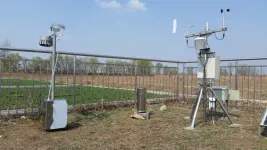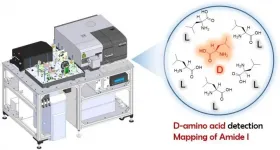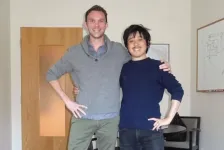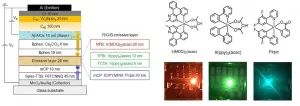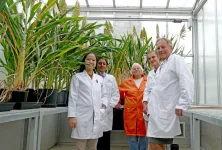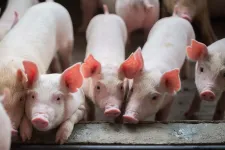A world first: A robot able to "hear" through the ear of a locust
Tel Aviv University researchers connect a real locust ear to a robot
2021-03-02
(Press-News.org) A technological and biological development that is unprecedented in Israel and the world has been achieved at Tel Aviv University. For the first time, the ear of a dead locust has been connected to a robot that receives the ear's electrical signals and responds accordingly. The result is extraordinary: When the researchers clap once, the locust's ear hears the sound and the robot moves forward; when the researchers clap twice, the robot moves backwards.
The interdisciplinary study was led by Idan Fishel, a joint master student under the joint supervision of Dr. Ben M. Maoz of the Iby and Aladar Fleischman Faculty of Engineering and the Sagol School of Neuroscience, Prof. Yossi Yovel and Prof. Amir Ayali, experts from the School of Zoology and the Sagol School of Neuroscience together with -, Dr. Anton Sheinin, Idan, Yoni Amit, and Neta Shavil. The results of the study were published in the prestigious journal Sensors.
The researchers explain that at the beginning of the study, they sought to examine how the advantages of biological systems could be integrated into technological systems, and how the senses of dead locust could be used as sensors for a robot. "We chose the sense of hearing, because it can be easily compared to existing technologies, in contrast to the sense of smell, for example, where the challenge is much greater," says Dr. Maoz. "Our task was to replace the robot's electronic microphone with a dead insect's ear, use the ear's ability to detect the electrical signals from the environment, in this case vibrations in the air, and, using a special chip, convert the insect input to that of the robot."
To carry out this unique and unconventional task, the interdisciplinary team (Maoz, Yovel and Ayali) faced number of challenged. In the first stage the researchers built a robot capable of responding to signals it receives from the environment. Then, in a multidisciplinary collaboration, the researchers were able to isolate and characterize the dead locust ear and keep it alive, that is, functional, long enough to successfully connect it to the robot. In the final stage, the researchers succeeded in finding a way to pick up the signals received by the locust's ear in a way that could be used by the robot. At the end of the process, the robot was able to "hear" the sounds and respond accordingly.
"Prof. Ayali's laboratory has extensive experience working with locusts, and they have developed the skills to isolate and characterize the ear," explains Dr. Maoz. "Prof. Yovel's laboratory built the robot and developed code that enables the robot to respond to electrical auditory signals. And my laboratory has developed a special device - Ear-on-a-Chip - that allows the ear to be kept alive throughout the experiment by supplying oxygen and food to the organ, while allowing the electrical signals to be taken out of the locust's ear and amplified and transmitted to the robot.
"In general, biological systems have a huge advantage over technological systems - both in terms of sensitivity and in terms of energy consumption. This initiative of Tel Aviv University researchers opens the door to sensory integrations between robots and insects - and may make much more cumbersome and expensive developments in the field of robotics redundant.
"It should be understood that biological systems expend negligible energy compared to electronic systems. They are miniature, and therefore also extremely economical and efficient. For the sake of comparison, a laptop consumes about 100 watts per hour, while the human brain consumes about 20 watts a day. Nature is much more advanced than we are, so we should use it. The principle we have demonstrated can be used and applied to other senses, such as smell, sight and touch. For example, some animals have amazing abilities to detect explosives or drugs; the creation of a robot with a biological nose could help us preserve human life and identify criminals in a way that is not possible today. Some animals know how to detect diseases. Others can sense earthquakes. The sky is the limit."
INFORMATION:
ELSE PRESS RELEASES FROM THIS DATE:
2021-03-02
Removal of pollutants from the air, or atmospheric deposition, is a natural cleaning mechanism. However, the removed toxic matters don't just disappear on the Earth. China's Soil Pollution Survey released in 2014 shows that 19.4% of the Chinese farmland soil was polluted and 82% of pollutant was toxic heavy metals such as cadmium, which can cause chronic health problems.
Atmospheric deposition is an important source of these heavy metals in the soil but it tends to be neglected. Unlike sources from irrigation water, sewage sludge, fertilizers and livestock manures, atmospheric deposition can't easily be perceived. And the paucity of measurements also makes it difficult to track what ...
2021-03-02
Currently, the roles of free D-amino acids and D-amino acid residues in proteins are garnering extensive attention in biological fields such as molecular biology, physiology, microbiology, and pathophysiology. Because it is crucial to analyze these materials rapidly and accurately, many methods have been employed. However, samples for measurement are currently limited to solutions containing target molecules in the pure form. Hence, there is need for an analytical method for the in situ measurement of biological samples placed on a solid support.
We report the construction of a multidimensional ...
2021-03-02
Earth's surface environments are highly oxygenated - from the atmosphere to the deepest reaches of the oceans, representing a hallmark of active photosynthetic biosphere. However, the fundamental timescale of the oxygen-rich atmosphere on Earth remains uncertain, particularly for the distant future. Solving this question has great ramifications not only for the future of Earth's biosphere but for the search for life on Earth-like planets beyond the solar system.
A new study published in Nature Geoscience this week tackles this problem using a numerical model of biogeochemistry and climate and reveals that the future lifespan ...
2021-03-02
In the group of Prof. Karl Leo, physicists, material scientists and engineers are working jointly on the development of novel organic materials and devices for high performance, flexible and possibly even biocompatible electronics and optoelectronics of the future. Increasing the performance of organic devices is one of the key challenges in their research. It was only last year, when the team headed by Dr. Hans Kleemann announced an important breakthrough with the development of efficient, printable vertical organic transistors.
Now Dr. Zhongbin Wu, Dr. Yuan Liu, and PhD student Erjuan Guo present the first electronic device that combines a vertical organic permeable base transistor (OPBT) and an OLED. With this novel device concept of an organic permeable base light-emitting ...
2021-03-02
Active or voluntary learning is a major topic in education, psychology, and neuroscience. Over the years, numerous studies have shown that when learning occurs through voluntary action, there is a modulation of attention, motivation and cognitive control that makes the process much more effective. Consequently, memory is benefited. However, although the physiological processes underlying this reality had been identified in the brain of mice, their existence in our species had not been corroborated.
Now, an international group of researchers led by ICREA Research Professor Paul Verschure from the SPECS laboratory at the Institute for Bioengineering of Catalonia (IBEC) and Professor Nikolai Axmacher from the Department of Neuropsychology at Ruhr-Universität ...
2021-03-02
The first observations of a space hurricane have been revealed in Earth's upper atmosphere, confirming their existence and shedding new light on the relationship between planets and space.
Hurricanes in the Earth's low atmosphere are known, but they had never before been detected in the upper atmosphere.
An international team of scientists led by Shandong University in China analysed observations made by satellites in 2014 to reveal a long-lasting hurricane, resembling those in the lower atmosphere, in the polar ionosphere and magnetosphere with surprisingly large energy and momentum deposition despite otherwise extremely quiet geomagnetic conditions.
The analysis ...
2021-03-02
The Acheulean was estimated to have died out around 200,000 years ago but the new findings suggest it may have persisted for much longer, creating over 100,000 years of overlap with more advanced technologies produced by Neanderthals and early modern humans.
The research team, led by Dr Alastair Key (Kent) alongside Dr David Roberts (Kent) and Dr Ivan Jaric (Biology Centre of the Czech Academy of Sciences), made the discovery whilst studying stone tool records from different regions across the world. Using statistical techniques new to archaeological science, the archaeologists and conservation experts were able to reconstruct the end of the Acheulean period and re-map the archaeological record.
Previously, ...
2021-03-02
An impressive body of evidence published this week reveals the answer to a mystery that has puzzled plant scientists for more than 30 years: the role of the molecule suberin in the leaves of some of our most productive crops. This discovery could be the key to engineering better crops and ensuring future food security.
Highly productive crops such as sugarcane, sorghum and maize belong to the type of plants that use the more efficient C4 photosynthetic pathway to transform water, sunlight and carbon dioxide (CO2) into sugars.
Scientists have known for a long time that one of key factors that makes C4 photosynthesis more efficient is that they have the capacity to ...
2021-03-02
LOS ALAMOS, N.M., March 1, 2021-- A novel computer algorithm that could create a broadly reactive influenza vaccine for swine flu also offers a path toward a pan-influenza vaccine and possibly a pan-coronavirus vaccine as well, according to a new paper published in Nature Communications.
"This work takes us a step closer to a pan-swine flu virus vaccine," said Bette Korber, a computational biologist at Los Alamos National Laboratory and a co-author on the paper. "The hope is to eventually be prepared with an effective and rapid response if another swine flu epidemic begins to spread in humans, but this swine flu vaccine could also be useful in a veterinary setting." The immune responses to the vaccine showed very promising breadth against diverse viral variants. "The same basic principles ...
2021-03-02
Nearly everything author Malcolm Gladwell said about how information spreads in his 2000 bestseller "The Tipping Point" is wrong, according to a recent study led by UCLA professor of sociology Gabriel Rossman.
"The main point of 'The Tipping Point' is if you want your idea to spread, you find the most popular person in the center of any given network and you sell them on your idea, and then they'll sell the rest of the world on it," Rossman said.
But Rossman's latest study, recently published in Proceedings of the National Academy of Sciences, pokes holes in that widely accepted notion ...
LAST 30 PRESS RELEASES:
[Press-News.org] A world first: A robot able to "hear" through the ear of a locust
Tel Aviv University researchers connect a real locust ear to a robot
